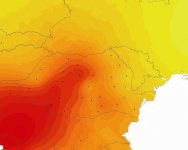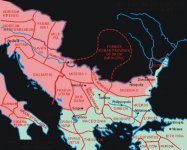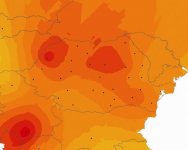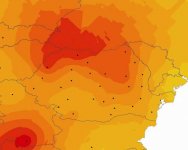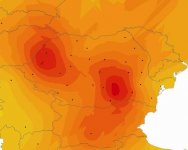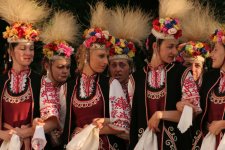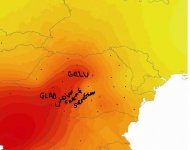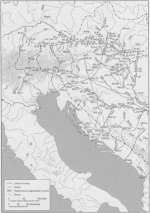"[The Vlachs] never kept their word to anyone, not even to the ancient Roman Emperors. Having been attacked in war by Emperor Trajan and having been defeated totally, they were subdued and their King, named Decebal, was killed and his head was put on a pike and brought to the city of the Romans. These [Vlachs] are, in fact, the so-called Dacians, also called Bessians [Bessoi]. Earlier they lived in the vicinity of the Danube and Saos, a river which we now call Sava, where the Serbians live today, and [later] withdrew to their inaccessible fortifications. Relying upon these fortifications, they feigned friendship and submission to the ancient Roman Emperors and then swept down from their strongholds and plundered the Roman provinces. Therefore, the exasperated Romans crushed them. And these left the region: some of them were dispersed to Epirus and Macedonia, and a large number established themselves in Hellas."
the text from Kekaumenos, "Ethnic Continuity in the Carpatho-Danubian Area", Elemér Illyés
For a Byzantine general like Kekaumenos, "along the Danube and Sava" obviously meant the land east of
Sirmium,towards Belgrade,Branicevo and Vidin.Sirmium,the most important Danubian town
for the Byzantines,a place of great strategic importance,especially in the relations with the
Hungarians,must have been eventually one of the main sources of informations for Kekaumenos.
The Byzantine military chief of Sirmium had the title of "strategos of Serbia",who was in charge
to defend a large section of the Danubian frontier,from this city until Vidin,that's why Kekaumenos
uses the words "along the Danube and Sava,WHERE NOW THE SERBS LIVE".
The Byzantines' most frequent name for the Hungarians was "Dacians",this,corroborated with
another geographical reference, the frontier of"the Danube and Sava",points that Kekaumenos obvioulsly places
the "Dacian" Vlachs, in the territory located north of the Danubian sector between Sirmium and Vidin,
in/near the Hungarian lands.For the Byzantines,the Hungarians and the Dacian Vlachs are "Dacians",
while the Bulgarians(with the core in the NE part of the country) and the Vlachs from the Haemus(Balkan
Mountains) are "Mysians".
But the Vlachs are also the "Bessi"from the Byzantine Empire,so the military mind conceives their
homeland in the contact zone with the Hungarian state,"along the Danube and Sava',to justify
the present "dispersion" and differentiation(Byzantine Bessi vs. Hungarian Dacians).
After Basil II's conquest of Bulgaria,the ecclesiastical structure is
reorganized in this territory,the seat of Vlach bishop was in Vreanoti,
today's Vranje,located in the
valley of Southern Morava,which is part of the "land of Bessi".
That's why Kekaumenos was definitely not the only Byzantine/Greek
who knew about the Vlach communities from this area.
"Komnena, like other Byzantine authoers, generally refers to the Hungarians as Dacians."
(Elemer Illyes,"Ethnic Continuity in the Carpatho-Danubian Area")
from Paul Stephenson,"Byzantium's Balkan Frontier":
"Anna adds that they were inspired
by the treachery of the Dacians. The latter were clearly the
Hungarians;
"A glance at any map of the middle Byzantine empire at its ‘apogee’ in
1025 will show that Basil II exercised authority throughout the lands of
the southern Slavs, and the border of his empire ran west along the Sava
and Danube from Sirmium to the Black Sea, and south the length of the
Adriatic coast from Istria through Dyrrachium and into Greece."
"In 1018 the patrikios Constantine Diogenes was designated commander
in Sirmium and the neighbouring territories. The geographical
range of Constantine Diogenes’ powers is remarkable, and he seems to
have enjoyed de iure authority across a wide, if poorly defined region
which stretched from Sirmium at least as far as Vidin, and then south
into the mountains of Raska (modern Serbia) and Bosna (Bosnia). A seal
in the Dumbarton Oaks collection bearing the legend ‘Constantine
Diogenes, [. . .] strategos of Serbia’ can only be attributed to this character."
"Geza I pursued a more friendly policy towards Byzantium. He was
married, probably in 1075, to the daughter of the Byzantine aristocrat
Theodoulus Synadenus,3 and received at that time the famous crown
which bears (on the reverse) his portrait on an enamel plaque beneath
that of the emperor Michael VII Ducas, and beside the image of
Constantine Ducas the porphyrogennetos."
"After the Byzantine defeats at Bari and Mantzikert in 1071 imperial authority
was challenged throughout the empire and from beyond the frontiers.
The Hungarian Chronicle relates how Belgrade came under attack
from the Hungarian King Salomon, where the Bulgarian and Greek
defenders used ‘Greek fire’ to set light to the Magyars’ ships. To deflect a
second assault they appealed to the Pechenegs (Bisseni), upon whom the
Magyars inflicted great slaughter. The besieged city fell after three months,
and many of the inhabitants were put to the sword before Salomon, and
the dukes Geza and Ladislas marched on to Nis, seizing much plunder en
route. The situation was resolved by negotiation soon thereafter, but it seems
probable that Salomon was allowed to keep the former Byzantine outpost
of Sirmium (modern Sremska Mitrovica), which sat on the northern bank
of the Sava, opposite the residence of the bishop of Sirmium (at
Macvanska Mitrovica)"
"In the same
way, the peoples who occupied the various lands might be called
‘Bulgarians’ (Boulgaroi), although other names were used more frequently,
and with little concern for contemporary accuracy. Thus the
Bulgarians are often called Mysoi, Mysians (but not Moesians) because
they occupied the lands of the former Roman province of Moesia."
"The Vlach-Bulgar rebellion was provoked by an arbitrary imperial
decision to levy taxes. Choniates relates that, in order
to raise money to celebrate his marriage to the daughter of Bela III,
Isaac levied an extraordinary tax. This fell most heavily on the settlements
in the vicinity of Anchialus and the Haemus mountains where the
‘barbarians . . . . formerly called Mysians (Mysoi), and now named Vlachs
(Vlachoi)’, were provoked to rebel"
"The region between the Sava and the Danube was then ceded by
Michael VII to Geza, in 1075, so that he would secure an ally and save at least the region
east of Belgrade, which remained under Byzantine rule nearly until the collapse of the
empire in 1204."
"Confrontations between Hungary,
the Byzantine Empire and Bulgaria
for the Belgrade–Vidin Border Region
in the 9th-14th Centuries",Alexandru Madgearu
"Donja Ljubata is situated ca. 15 km west of Bosilegrad,
at the natural communication connecting this region
with the Vranje–Bujanovac Basin"
"Bowl from Davidovac, situated between Vranje and
Bujanovac, decorated with cogwheel tool and circular stamps, kept
in the National Museum in Vranje."
https://www.google.ro/url?sa=t&rct=...Rkf0FvA3bbw0h1SkTziVnA&bvm=bv.127984354,d.bGs
"Nadalje ,u njoj se prvi pu t spominju vlaški vjernici koji su raštrkani na čitavom područj u tearhiepiskopije , tak o reći na čitavom Balkanu . Za njih osniva i zasebn u episkopiju,poznat u ka o vlaška episkopija, koju Mathia s Gy6ni lokalizira na područj uBabune , sjeverno od Prilepa u blizini Velesa, gdje se nalaz e dva sela s imeno mGornj i i Donji Vranovci, a ta se episkopija naziva Vreanotes™ što se svakako prijemož e identificirati s Vranjem"
https://www.google.ro/url?sa=t&rct=...WYwutMuq5OhguqRlg5Nwsw&bvm=bv.127984354,d.bGg
" According to a German historian, there apparently was a bishopric of "the Vlachs" with its residence at "Vreanoti" (Vranje) on the upper reaches of the Morava river"
http://www.farsarotul.org/nl27_3.htm


